Engineering Academic Units
School of Aeronautics and Astronautics
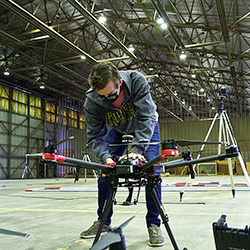
The Aeronautics and Astronautics curriculum emphasizes the disciplines of aerodynamics, aerospace systems, astrodynamics and space applications, propulsion, structures and materials, dynamics and control, and further provides courses that integrate these disciplines into the design of flight vehicles to perform the required mission.
The field of aeronautical and astronautical engineering addresses the challenging problems encountered in the design and operation of many types of aircraft, missiles, and space vehicles and places a constant demand on research and development groups for an even greater understanding of basic physical phenomena.
Employers from around the world contact the School of Aeronautics and Astronautics with information regarding positions available within their organizations.
Agricultural and Biological Engineering
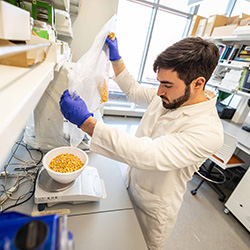
Agricultural Engineering prepares engineers with specialized expertise to design and analyze new and environmentally sound ways of utilizing natural resources.
Machine systems engineering prepares engineers with backgrounds in areas like mechanical design, hydraulics, instrumentation and control, and electronics and sensors to design and operate machines and systems for agricultural and biological products and processes.
Biological Engineering prepares graduates to apply basic scientific and engineering principles to the design, development, and operation surrounding the large-scale manufacturing of food and biologically based products. Such products are environmentally friendly and renewable, representing a future wave of consumer demand for better health and environment.
Weldon School of Biomedical Engineering

Biomedical Engineering applies principles and methods of engineering and life sciences to design solutions for human biology and medicine.
Undergraduate students take life-science courses in combination with engineering design courses, studying physical and chemical properties of human tissues in order to design more effective implants. Other areas and projects include cell and tissue research, as well as the design of new biomaterials for use in medical therapies.
The Weldon School of Biomedical Engineering will be housed in a state-of-the-art building designed to enhance both teaching and research. The $25-million, 91,000-square-foot facility (to be completed in spring 2006) will accommodate the rapid growth of biomedical engineering and its exponential increase in job opportunities.
Programs of focus include biomaterials, musculoskeletal biomechanics, tissue engineering, medical imaging, cardiovascular instrumentation, therapeutic and diagnostic devices, and biological signal processing.
Davidson School of Chemical Engineering
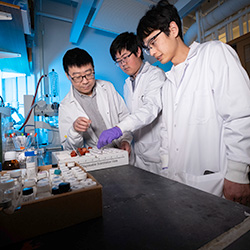 Chemical Engineering at Purdue continues to be among the premier chemical engineering programs in the world. Our mission is to provide students with a rigorous and relevant education, conduct field-defining research, and enhance the School’s global impact.
Chemical Engineering at Purdue continues to be among the premier chemical engineering programs in the world. Our mission is to provide students with a rigorous and relevant education, conduct field-defining research, and enhance the School’s global impact.
Chemical engineers work in a wide range of industries with worldwide impact. Applications include energy; pharmaceuticals and biological materials; the nutritional value of food; environmental protection and restoration; materials for computing, sensing, and communications; personal care, home care, and home health products; and system and data management.
The School of Chemical Engineering at Purdue University has a commitment to performing field-defining research that is regarded worldwide for its impact and quality. Our faculty is among the largest in the country. We are proud of our distinguished faculty members, including six elected members to the National Academy of Engineering and a recipient of the National Medal of Technology and Innovation. The range of research topics pursued at Purdue is broad, and can be explored by fundamental topic area or by application area https://engineering.purdue.edu/ChE/Research.
The Chemical Engineering facilities are comprised of the original building (47,110 asf) which has been extensively renovated, and a five-story addition (44,544 sf), both equipped with state-of-the-art technologies and instrumentation. The quality and diversity of our equipment and facilities enable our student and faculty researchers to push the boundaries of science and engineering.
Lyles School of Civil Engineering
 Civil Engineers shape the world. Civil Engineering is founded on creating, designing, and improving communities. We teach our students to apply sustainable design principles and problem-solving skills to systems of natural and built environments. Civil Engineers are constantly working to engineer a better future for people and our planet by creating new landmarks for our cities and nations, implementing systems that preserve and improve our natural resources, developing sustainable networks that provide clean energy, and building the infrastructure that allows us to move and take shelter safely and efficiently.
Civil Engineers shape the world. Civil Engineering is founded on creating, designing, and improving communities. We teach our students to apply sustainable design principles and problem-solving skills to systems of natural and built environments. Civil Engineers are constantly working to engineer a better future for people and our planet by creating new landmarks for our cities and nations, implementing systems that preserve and improve our natural resources, developing sustainable networks that provide clean energy, and building the infrastructure that allows us to move and take shelter safely and efficiently.
Purdue's Civil Engineering Program prepares students to tackle future challenges and serve as key stakeholders in improving our society. Our program offers multiple pathways for students to find their passion. With ten open technical electives courses, students can tailor their education towards a desired future career.
Instructional laboratories in structural behavior, geotechnics, hydraulics, geomatics, environmental, and civil engineering materials enable experiential learning that reinforces theory. Our deeply-committed faculty serve as upperclassman advisors, providing many opportunities to interact and develop relationships with those that are creating the future of civil engineering. For the final year in civil engineering, students participate in a capstone Senior Design course where diverse teams tackle projects through real world applications and theoretical role play.
The Future of Civil Engineering is founded in the research we conduct. These innovations are developed by our students and faculty then created and tested in our world-renowned facilities. With faculty and student research, we collaboratively design sustainable, safe, resilient and reliable infrastructure and environmental solutions of the future.
Department of Computer Science

Founded in 1962, the Department of Computer Science was created to be an innovative base of knowledge in the emerging field of computing as the first degree-awarding program in the United States. The department continues to advance the computer science industry through research. Graduates of the program are able to solve complex and challenging problems in many fields. The increasing centrality of computer science in academic disciplines and society, and new research activities - centered around data science, artificial intelligence, programming languages, theoretical computer science, machine learning, and cybersecurity - are the future focus of the department.
Division of Construction Engineering and Management
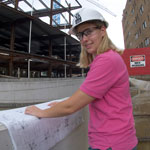
The Division of Construction Engineering and Management (CEM) offers a degree in Construction Engineering (BSCNE) which is tailored to prepare graduates for professional work in the construction industry. The Construction Engineering curriculum includes about 80 percent engineering courses and 20 percent management courses focused on the knowledge necessary for construction careers.
Since the inception of the program in the late 1970's BSCNE graduates have been hired at a 100-percent rate upon graduation by some of the 100 top U.S. construction firms
Many construction engineers move into senior management, attaining executive positions and even ownership in a construction firm. These professionals have a passion for building structures and collaborating with a wide range of people, as well as a desire to learn in a constantly changing world.
School of Electrical and Computer Engineering
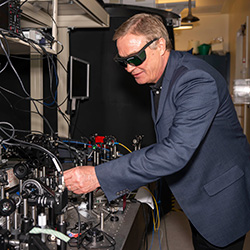 Electrical and Computer Engineering – a discipline that plays a central role in the ongoing technology and information revolution – encompasses the development, design, research, and operation of electrical and electronic systems and components, including computers. Sub-disciplines include: automatic control; biomedical imaging and sensing; communications, networking, signal and image processing; computer engineering; fields and optics; microelectronics and nanotechnology; power and energy systems; and VLSI and circuit design.
Electrical and Computer Engineering – a discipline that plays a central role in the ongoing technology and information revolution – encompasses the development, design, research, and operation of electrical and electronic systems and components, including computers. Sub-disciplines include: automatic control; biomedical imaging and sensing; communications, networking, signal and image processing; computer engineering; fields and optics; microelectronics and nanotechnology; power and energy systems; and VLSI and circuit design.
Undergraduate students have the option of pursuing a bachelor’s degree in either Electrical Engineering (BSEE) or Computer Engineering (BSCmpE). BSEE graduates design, develop and work with a wide range of technologies including biomedical devices, computer chips, communication devices, microcontrollers, lasers, robots, and electrical machines. BSCmpE graduates are provided with a broad view of the computer field with courses covering the full range of hardware and software design, covering the sub-areas of computer architecture, software systems, and intelligent systems. Both degree programs benefit from state-of-the-art laboratories that provide hands-on experience that culminates in a capstone senior-design project.
All students, especially those at the graduate level, have the opportunity to pursue world-class research in any of the ECE sub-disciplines at top-notch facilities in the three buildings that house ECE: The EE building, the MSEE building, and Wang Hall. Also available for research in experimental microelectronics and nanotechnology are the facilities at the Birck Nanotechnology Center in Discovery Park, at whose heart is a 25,000 sq. ft. class 1-10-100 nanofabrication cleanroom (Scifres Nanofabrication Laboratory).
School of Engineering Education
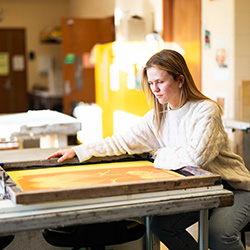 The First-Year Engineering Program is a student-oriented, service program tasked with recruiting, advising, teaching, and retaining outstanding Purdue Engineering students. The first-year curriculum provides a solid academic foundation and overview of engineering fields and careers.
The First-Year Engineering Program is a student-oriented, service program tasked with recruiting, advising, teaching, and retaining outstanding Purdue Engineering students. The first-year curriculum provides a solid academic foundation and overview of engineering fields and careers.
The Interdisciplinary Engineering Studies Program is for the undergraduate engineering student who want an engineering education but do not plan to practice engineering (eg. Pre-Medical Engineering Studies).
The Multidisciplinary Engineering Program is for students who want to practice engineering but whose career goals cannot be accommodated within a traditional engineering field. The MDE Program is a concentration that undergraduate students interested in bringing together multiple engineering disciplines at an advanced level to solve societal challenges.
The graduate programs serve students interested in studying the science of learning engineering. They focus on engineering education discovery, scholarship, and academic reform.
Environmental and Ecological Engineering
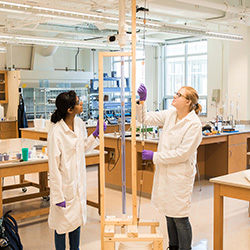
Environmental and Ecological engineers use the principles of systems engineering, biology, and chemistry to develop strategies to protect human and environmental health. Our unique name, Environmental and Ecological Engineering, was chosen to highlight our approach to managing complex problems with an integrated perspective that considers both environmental issues and ecological interactions. In the undergraduate curriculum there is an early focus on systems thinking and systems understanding with the inclusion of significant course requirements in ecology, sustainability, and industrial ecology. The EEE program strives for resilient design thinking that takes into account complexity and connectivity between systems.
Employment opportunities for EEE graduates are excellent. The U.S. Dept. of Labor projects substantial growth in jobs for the foreseeable future. Starting salaries are comparable to other Engineering fields and opportunities for advancement to positions of responsibility are excellent.
Among the 14 “Grand Challenges of Engineering” announced by the National Academy of Engineering six of the 14 are explicitly in the domain of Environmental and Ecological engineering. Environmental engineering has a clear impact on societies and quality of life. Students interested in engineering that can make a positive difference for people should consider Environmental and Ecological Engineering. Meet with an advisor or faculty member to craft an individualized plan of study to meet your career goals.
Research within Environmental and Ecological Engineering may be characterized as being multidisciplinary and focused on cutting edge issues. The EEE discovery mission is positioned to respond to society’s need to understand the world we live in, and to develop strategies for sustainably managing Earth’s limited resources and ecosystems so that they will be available for generations to come. Topics emphasized within the EEE research portfolio include: environmental fate of air, water, and soil contaminants; sustainable urban design; renewable energy and the water-energy nexus; water and wastewater treatment; sustainable industrial systems; water, air, and nutrient cycling; sustainability engineering education; bio-based materials and products; industrial ecology and industrial processes; air quality.
School of Industrial Engineering
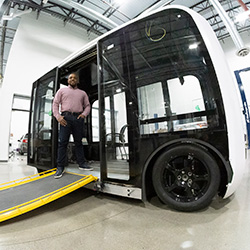
Industrial Engineering entails designing and controlling complex systems and procedures for using production resources (people, information, equipment, and materials). The applications of industrial engineering principles can be found in manufacturing, postal/package delivery services, airlines, space programs, hospitals, banks, amusement parks, etc.
Senior design projects consist of a real-world application of IE principles by teaming students with a local industry in Indiana. Teams have taken on full-scale projects like designing floor layouts for factories and hospitals, designing operations to improve system efficiency, reducing time and waste in processing, allocating resources to optimize system performance, and developing a safety plan for preventing work-related injuries.
Disciplines in the major include production, operation research, manufacturing, and human factors.
School of Materials Engineering
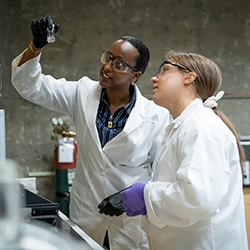
In everything we build—cars, planes, boats, computers, cell phones, bridges, skyscrapers, dental implants—the properties of the materials used determine the product's performance.
Materials Engineering's academic programs have been developed around broad and basic phenomena, applied to all major classes of artificial materials—ceramics, metals, glasses, polymers, and semiconductors. The undergraduate and graduate programs integrate our faculty strengths across the field's four cornerstones: structure, properties, processing, and performance.
Purdue's School of Materials Engineering is dedicated to meeting the materials needs of modern society through:
Learning—training the next generation of materials experts for every industrial sector;
Outreach—providing leadership within the materials profession;
School of Mechanical Engineering

Mechanical engineering, the oldest and broadest of engineering disciplines, involves the design, analysis, and manufacturing of mechanical, thermal or electronic systems. The diversity of the field has made the work of mechanical engineers critical to problem solving in virtually every field of technology.
Purdue’s mechanical engineering program balances theory and practice. Our strong curriculum gives students a solid grounding in the theory behind traditional and emerging areas in mechanical engineering and provides a strong hands-on component through labs, design and build activities and student machine shops. Students also can apply what they have learned through one-on-one research with a faculty member in their chosen area of interest. Our graduates depart with a rich understanding of engineering theories, along with an ability to apply these theories to real-life problems in real-life situations.
The school's extensive facilities include two major satellite research laboratories: The Ray W. Herrick Laboratories provide facilities for research in mechanical vibrations, noise control, acoustics, fluid mechanics, and heat transfer for energy utilization. The Zucrow Laboratories, named after their founder, started out in 1948 as one of the country's first liquid-rocket test facilities. Research in the laboratories, located next to the Purdue Airport, has expanded into combustion, propulsion, and fluid dynamics.
School of Nuclear Engineering

Nuclear engineering is firmly grounded in the understanding and application of modern physics. It has demonstrated vast potential for growth in power generation, medicine, industrial processes and engineering plasmas, space technologies, and national defense.
Nuclear engineers at Purdue contribute to such advanced technologies as fission and fusion power plasma physics, beam-target interactions, computational physics, new medical technologies and procedures, improved food safety, advanced materials processing, advanced imaging, and the safe treatment and disposal of spent nuclear fuel.
Students experience the small-classroom feel. Because Nuclear Engineering is a relatively small school, Undergraduate students experience closer interaction with professors. Currently the School of Nuclear Engineering has about 14 professors.
Indiana's first and only nuclear reactor (PUR-1) has its home at Purdue University. PUR-1 is a great teaching tool for our students. It headlines field trips for high-school juniors and seniors who participate in demonstrations and experiments.
